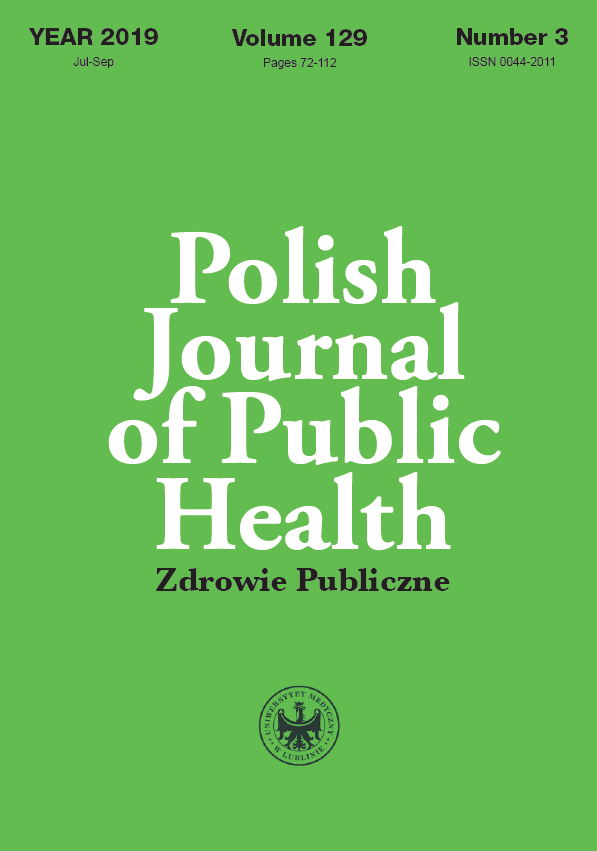Competitiveness of private specialist medical entities in the opinion of service recipients
DOI:
https://doi.org/10.2478/pjph-2019-0019Keywords:
Competitiveness, Competitive Health Plan, Healthcare Quality AssessmentAbstract
Introduction. The phenomenon of competitiveness and pressure of competitors that influence private medical institutions lead to the quest for new solutions on managing and defining determinants, which will provide advance of the institution over competing entities
Aim. The purpose of the study was to determine factors influencing competitiveness of a medical institution according to the beneficiaries.
Material and methods. The study group comprised 127 patients who used the services of private specialised medical institutions.
Results and conclusions. The phenomenon of competitiveness in chosen types of medical services was noticed by 69% (88) of beneficiaries. High quality of services 79% (100), short waiting time for appointments 70% (89) and competitive prices 55% (70) are the main determinants of the competitiveness of those institutions.
References
1. Ryć K, Skrzypczak Z. Ochrona zdrowia i gospodarka. Sektor publiczny a rynek. Warszawa: Wydawnictwo Naukowe Wydziału Zarządzania Uniwersytetu Warszawskiego; 2007. p. 35.
2. Paszkowska M. Zarządzanie podmiotami wykonującymi działalność leczniczą. Warszawa: Difin SA; 2015. p. 44.
3. Szarycz M. Refleksja nad etycznym podejściem do konkurowania w kontekście misji, wizji i celów firm farmaceutycznych działających na rynku polskim. Pielęg Pol. 2010;2(36):94-7
4. Pierścionek Z. Strategie konkurencji i rozwoju przedsiębiorstwa. Warszawa: Wydawnictwo Naukowe PWN; 2007. p.165.
5. Dyjas W. Uwarunkowania konkurencyjność prywatnych specjalistycznych podmiotów leczniczych. Praca magisterska. Katowice; 2018.
6. Andritsos DA, Tang ChS. Introducing competition in healthcare services: The role of private care and increased patient mobility. EJOR. 2014;234:898-909.
7. Everhart D, Neff D. The effects of nurse staffing on hospital financial performance: competitive versus less competitive markets. Health Care Manage Rev. 2013;38(2):146-55.
8. Budrevičiūtė A, Kalėdienė R, Petrauskienė J. Priorities in effective management of primary health care institutions in Lithuania: Perspectives of managers of public and private primary health care institutions. PLoS One. 2018;13(12):e0209816.
9. Gadelha CA, Costa LS, Maldonado J. The economic-industrial health care complex and the social and economic dimension of development. Rev Saude Publica. 2012;46 Suppl 1:21-8.
10. Gheorghe CM, Purcărea VL, Gheorghe IL. A marketing perspective on consumer perceived competition in private ophthalmology services. Rom J Ophthalmol. 2018;62(2)
11. Determann D, Lambooij MS, de Bekker-Grob EW. What health plans do people prefer? The trade-off between premium and provider choice. Soc Sci Med. 12016;65:10-8.
12. Brekkea KR, Cellini R, Siciliani L, Straume OR. Competition and quality in health care markets: A differential-game approach. J Health Econ. 2010;29:508-23.
13. Westra D, Angeli F, Carree M, Ruwaard D. Understanding competition between healthcare providers: Introducing an intermediary inter-organizational perspective. Health Policy. 2017;121:149-57.
14. Parkinson MD. The Healthy Health Care Workplace: a Competitive Advantage. Curr Cardiol Rep. 2018;20:98.
Downloads
Published
Issue
Section
License
Copyright (c) 2020 Polish Journal of Public Health

This work is licensed under a Creative Commons Attribution-NonCommercial-NoDerivatives 3.0 Unported License.


